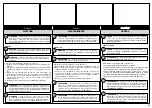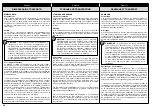
32
33
34
35
Italiano
English
Français
RIMESSAGGIO E TRASPORTO
STORAGE AND TRANSPORTING
REMISAGE ET TRANSPORT
La durata di stoccaggio del carburante può essere allungata
aggiungendo un apposito additivo stabilizzatore, oppure i
problemi dovuti al deterioramento possono essere evitati
svuotando preventivamente il serbatoio e il carburatore.
Per rallentare il deterioramento, mantenere la benzina in un
recipiente certificato per carburanti.
Aggiunta di un additivo stabilizzatore per allungare la
durata di stoccaggio
Quando si aggiunge un additivo stabilizzatore, riempire il
serbatoio del carburante con benzina fresca. Se il serbatoio
è semivuoto, l'aria favorirà il deterioramento del carburante
durante lo stoccaggio. Se si tiene una tanica di benzina per il
rifornimento, assicurarsi che la benzina che contiene non sia
vecchia.
1. Aggiungere l'additivo stabilizzatore seguendo le istruzioni
del produttore.
2. Dopo avere aggiunto l'additivo stabilizzatore, far funzionare
il motore per 10 minuti all'aperto per essere sicuri che nel
carburatore la benzina trattata rimpiazzi quella non trattata.
3. Arrestare il motore.
Svuotamento del serbatoio del carburante e del
carburatore
1. Collocare un contenitore omologato per la benzina sotto
il carburatore e usare un imbuto per evitare spargimenti di
carburante.
2. Togliere il bullone di scarico (A, Fig.33) del carburatore e la
rondella di tenuta (B).
3. Dopo avere scaricato tutto il carburante nel contenitore,
rimontare il bullone di scarico (A) e la rondella di tenuta (B).
Stringere a fondo entrambi.
Precauzioni per il rimessaggio
1. Sostituire l'olio motore.
2. Smontare la candela di accensione.
3. Versare l'equivalente di un cucchiaio da cucina (5-10 cc) di
olio motore pulito nel cilindro (Fig.34).
Adding a fuel stabilizer to extend fuel storage life
When adding a fuel stabilizer, fill the fuel tank with fresh
gasoline. If only partially filled, air in the tank will promote
fuel deterioration during storage. If you keep a container
of gasoline for refueling, be sure that it contains only fresh
gasoline.
1. Add fuel stabilizer following the manufacturer’s instructions.
2. After adding a fuel stabilizer, run the engine outdoors for 10
minutes to be sure that treated gasoline has replaced the
untreated gasoline in the carburetor.
3. Stop the engine.
Draining the fuel tank and carburetor
1. Place an approved gasoline container below the carburetor,
and use a funnel to avoid spilling fuel.
2. Remove the carburetor drain bolt (A, Fig.33) and sealing
washer (B).
3. After all the fuel has drain into the container, reinstall the
drain bolt (A) and sealing washer (B). Tighten them securely.
Storage Precautions
1. Change the engine oil.
2. Remove the spark plugs.
3. Pour a tablespoon (5-10 cc) of clean engine oil into the
cylinder (Fig.34).
4. Pull the starter rope several times to distribute the oil in the
cylinder (Fig.35).
5. Reinstall the spark plugs.
6. Pull the starter rope slowly until resistance is felt. This
will close the valves so moisture cannot enter the engine
cylinder. Return the starter rope gently.
7. With the engine and exhaust system cool, cover the engine
to keep out dust. A hot engine and exhaust system can
ignite or melt some materials. Do not use sheet plastic as a
dust cover. A nonporous cover will trap moisture around the
engine, promoting rust and corrosion.
La Garantie du distributeur ne couvre ni les dommages au
système d'alimentation ni une mauvaise performance du
moteur liés au non respect des consignes d'entreposage.
La durée d'entreposage du carburant peut être prolongée grâce
à l'ajout d'un additif stabilisateur. Afin d'éviter toute détérioration
du moteur, il faut d'avoir la précaution de vider entièrement le
réservoir et le carburateur et de conserver l'essence dans un
récipient homologué pour l'entreposage de carburants.
Ajout d'un additif stabilisateur pour prolonger la durée
d'entreposage
Lorsque vous ajoutez un additif stabilisateur, remplissez d'essence
le réservoir de carburant. Si le réservoir est à moitié plein, l'air
favorisera la détérioration du carburant lors du stockage. Si vous
disposez d'un bidon d'essence pour vous ravitailler, assurez-vous
que l'essence qu'il contient n'est pas vieille.
1. Ajoutez l'additif stabilisateur en suivant les instructions du
constructeur
2. Après avoir ajouté l'additif stabilisateur, faites tourner le
moteur pendant 10 minutes en plein air, pour vous assurer
que l'essence traitée remplace celle non traitée dans le
carburateur.
3. Arrêtez le moteur.
Vidange du réservoir de carburant et du carburateur
1. Placez sous le carburateur un récipient homologué pour
l'essence et utilisez un entonnoir pour éviter le carburant.
2. Dévisser le boulon de vidange (A, Fig.33) du carburateur et
la rondelle de maintien (B).
3. Une fois la vidange terminée, replacez le boulon de vidange
(A), ainsi que la rondelle de maintien (B) et serrez à fond.
Précautions pour le remisage
1. Remplacez l'huile du moteur.
2. Démontez la bougie d'allumage.
3. Versez l'équivalent d'une cuillère à soupe (5-10 cc) d'huile
de moteur nouvelle dans le cylindre (Fig.34).













































